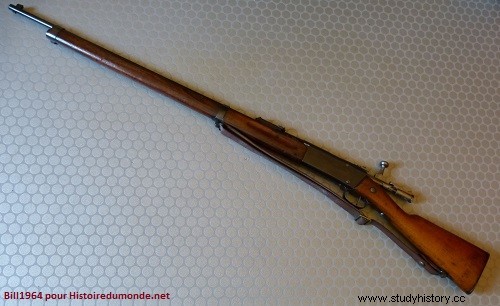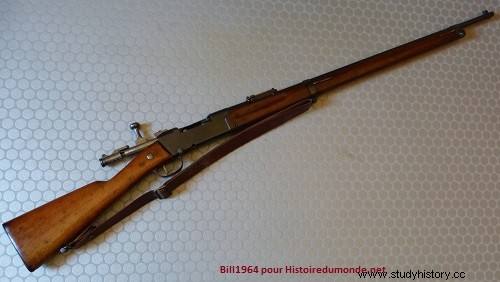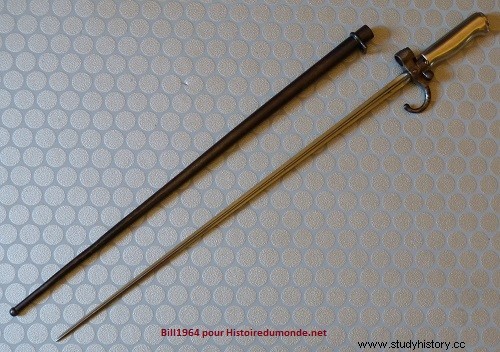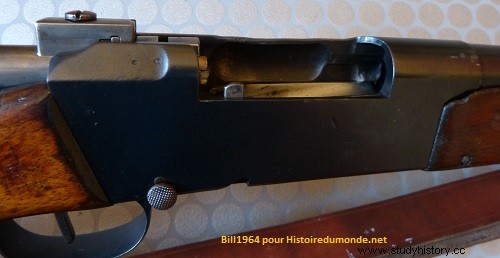
Around the years 1875-1880, two major questions arose in the military circles of the various nations; on the one hand the adoption for the infantry of repeating weapons and on the other hand the advisability of a further reduction in caliber, below 10 mm.
These questions were debated, because the adoption of repeating and small-caliber weapons required a complete overhaul of military tactics.
A historical fact was going to force the decision; the battle of Plevna in September 1877. It was there that for the first time on a European battlefield opposing Russians and Turks, repeating weapons made their appearance. The latter (Winchester 1866 cavalry carbines), used by the strongly entrenched Turkish soldiers on the outskirts of the city, literally tore the mass of Russian troops to pieces with intense, short-range salvo fire. The proof was in:the single-shot rifle had lived.
There remained the question of the reduction in caliber, made difficult by the heavy fouling resulting from black powder shooting; but in 1884, the Inspector General of Powders and Saltpeters Paul Vieille (1854-1934), managed to develop a powder that burned almost without leaving any residue and produced very little smoke. This powder, naturally called "smokeless powder", had moreover a power three times greater than that of black powder.
The definitive solution to the problem of small arms had just been found.
It was immediately decided to adopt this new powder (produced in secret and camouflaged under the name "Poudre V" or "Poudre B") for the loading of the cartridge of a new shotgun. repetition whose caliber would be reduced to 8 mm.
A study commission existed to study the development of new weapons; under the presidency of General Tramond, it was composed of Colonels Bonnet and Lebel, Colonel Gras, Captain Desaleux and M. Vieille.
Appointed Minister of War in January 1886, the bubbling General Boulanger demanded immediate results from the commission, and that the new regulatory rifle be presented to him by May 1 of the same year!
Of course , it is then no longer a question of studying the development of an entirely new weapon, but of producing as quickly and as best as possible, from what we already have.
The only solution is the reduction to the caliber of 8 mm of the rifle model 1885, repeating rifle equipped with a longitudinal store under the barrel (Kropatschek system), adopted recently but whose manufacture had been limited, its ammunition of 11 mm black powder making it already almost obsolete.

The feat is achieved and the weapon is ready within time allowed, the first specimens were quickly tried out in the troops and the new rifle was adopted at the beginning of 1887.
It was referred to as the "Fusil Modèle 1886", but it was under the name of rifle Lebel that it will remain known and will become famous. Colonel Lebel, commandant of the Ecole Normale de Tir de Châlons, was only one of the members of the "Repeating Weapons Commission", but it is his name that has gone down in history.
The commission also decided that, for the first time in the history of armament, all the parts of the new weapon should be strictly interchangeable; this implied that they were machined in a factory and in very large series, on the most modern machine tools (especially from the United States).
The result is a superb weapon whose the quality of finish and the elegant lines force the admiration of all. The Lebel rifle is undoubtedly one of the most beautiful rifles ever built and the cartridge it fires puts it, in 1887, at the forefront of world military weapons.
Slightly modified in 1893 ( see below), the Lebel will be the symbol of the French soldier of the First World War.
 Lebel bayonet called "Rosalie" the rifle itself being nicknamed "Oscar"
Lebel bayonet called "Rosalie" the rifle itself being nicknamed "Oscar"
Operation of the 1886 rifle (and 1886 M93):
1° Loading the magazine:place the fire selector (checkered button) on the "repeat" position, open the mobile bolt and release the opening of the magazine tube by pressing with the thumb on the trough-transporter. Introduce one by one 8 cartridges in a row, place a 9ᵉ in the bucket-transporter. rises and the cartridge in it is placed in front of the chamber. Closing the breech, the cartridge is pushed into the chamber, when locking the breech, the trough automatically lowers and receives the first cartridge from the magazine. After the shot has fired, the simple act of opening the breech ejects the empty case and raises the carrier-auger which presents a new cartridge in front of the chamber.
3° Shooting shot by shot:If you want to keep the magazine full, simply push the selector to the “shot by shot” position. The trough-conveyor is then permanently blocked in the raised position. The shot is then carried out as with a single-shot rifle, each time introducing a cartridge directly into the chamber.
This complicated mechanism requires great care in manufacturing and adjustment of its parts and is prone to jamming when the gun is used in mud or snow; it is nevertheless fully developed in the 1886 M93 rifle.
Once the magazine is filled to 8 rounds, repeat firing is very fast, but reloading the magazine is very long, which makes that the average speed of fire from a rifle with a tubular magazine of the Kropatschek type is hardly higher than that obtained from a single-shot weapon.

DESCRIPTIVE SHEET:
Overall length :1.307 m without bayonet; 1.82 m with its bayonet.
Barrel length :0.800 m.
Caliber :8 mm.
Weight weight:4.18 kg, magazine empty.
Epee-bayonet with quadrangular blade with hollow sides, total length:0.638 m.
Repeating system:magazine of 8 cartridges in line under the barrel.
Barrel striped with 4 stripes on the left, 24 cm pitch.
Rise with steps and board:steps corresponding to distances between 400 and 800 meters. Goal in white of 250 meters with board of rise folded forwards. The slider carries a third rear sight used for distances from 900 to 2,400 meters when the planchette is raised.
The barrel and the breech box are carefully blued, the bolt carrier is made of steel polite. The sword-bayonet has the shape of a long needle, it is composed of a quadrangular polished steel blade, an all-metal hilt and a cruise with steel socket and quillon. The scabbard is bronzed.
Modification of 1893:It consists essentially in the addition of a "buffer-mask" on the head of the breech, to better protect the shooter against possible projections of gas following rupture of the cartridge base, and in the adoption of a claw foot for the rear sight. This transformation was systematically applied to the 1886 rifles, which then took their definitive name of “Fusil 1886 M93”.
